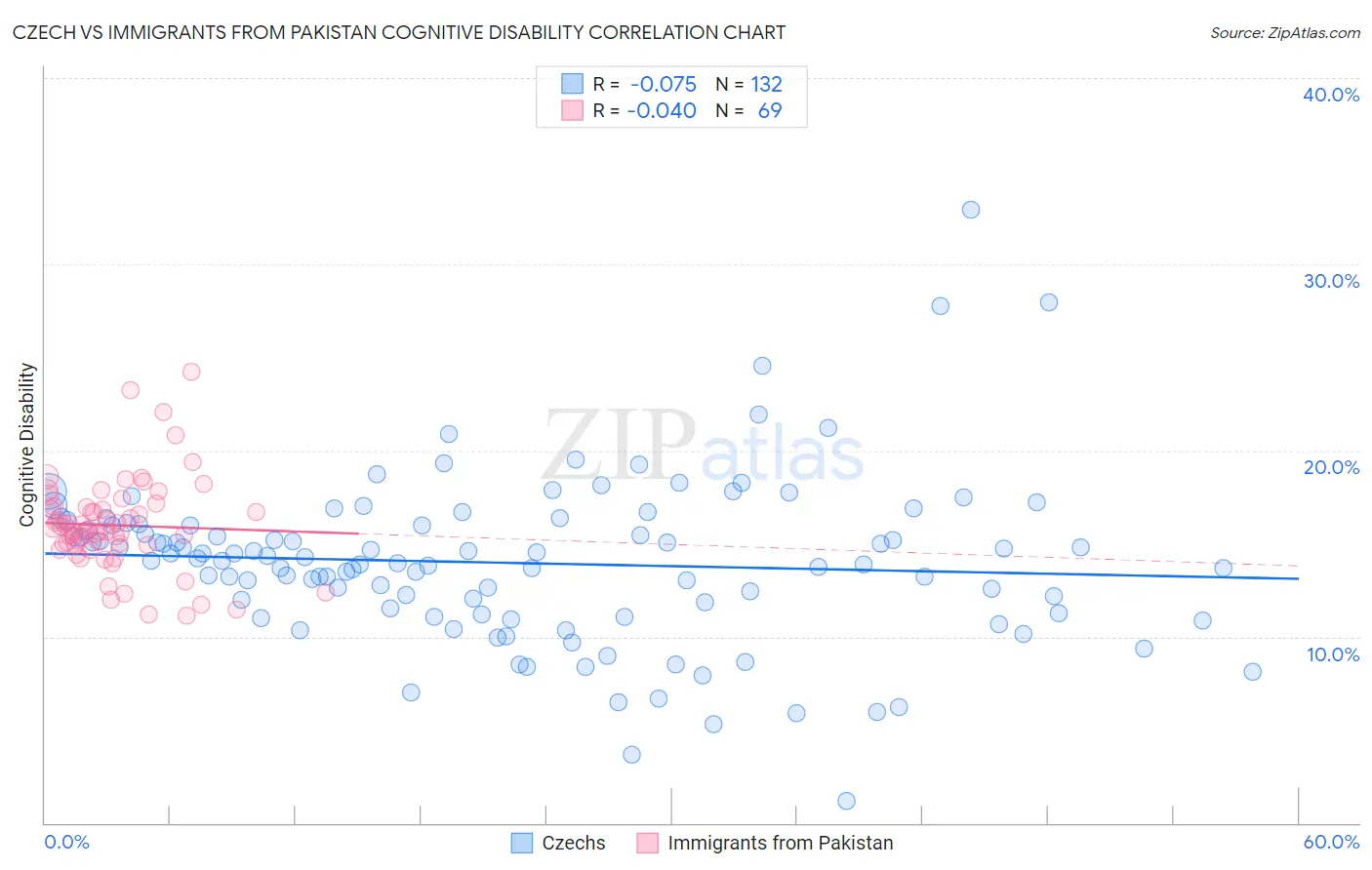Czech vs Immigrants from Pakistan Cognitive Disability
COMPARE
Czech
Immigrants from Pakistan
Cognitive Disability
Cognitive Disability Comparison
Czechs
Immigrants from Pakistan
16.4%
COGNITIVE DISABILITY
99.9/ 100
METRIC RATING
30th/ 347
METRIC RANK
16.4%
COGNITIVE DISABILITY
99.9/ 100
METRIC RATING
27th/ 347
METRIC RANK
Czech vs Immigrants from Pakistan Cognitive Disability Correlation Chart
The statistical analysis conducted on geographies consisting of 484,743,035 people shows a slight negative correlation between the proportion of Czechs and percentage of population with cognitive disability in the United States with a correlation coefficient (R) of -0.075 and weighted average of 16.4%. Similarly, the statistical analysis conducted on geographies consisting of 283,893,099 people shows no correlation between the proportion of Immigrants from Pakistan and percentage of population with cognitive disability in the United States with a correlation coefficient (R) of -0.040 and weighted average of 16.4%, a difference of 0.030%.

Cognitive Disability Correlation Summary
| Measurement | Czech | Immigrants from Pakistan |
| Minimum | 1.2% | 11.1% |
| Maximum | 32.9% | 24.2% |
| Range | 31.7% | 13.1% |
| Mean | 14.0% | 16.0% |
| Median | 14.1% | 15.8% |
| Interquartile 25% (IQ1) | 11.4% | 14.9% |
| Interquartile 75% (IQ3) | 16.0% | 17.0% |
| Interquartile Range (IQR) | 4.6% | 2.1% |
| Standard Deviation (Sample) | 4.4% | 2.5% |
| Standard Deviation (Population) | 4.4% | 2.5% |
Demographics Similar to Czechs and Immigrants from Pakistan by Cognitive Disability
In terms of cognitive disability, the demographic groups most similar to Czechs are Filipino (16.4%, a difference of 0.0%), Immigrants from Romania (16.4%, a difference of 0.020%), Polish (16.4%, a difference of 0.030%), Immigrants from Croatia (16.4%, a difference of 0.050%), and Immigrants from Israel (16.4%, a difference of 0.070%). Similarly, the demographic groups most similar to Immigrants from Pakistan are Polish (16.4%, a difference of 0.0%), Immigrants from Croatia (16.4%, a difference of 0.020%), Filipino (16.4%, a difference of 0.030%), Luxembourger (16.4%, a difference of 0.050%), and Immigrants from Romania (16.4%, a difference of 0.050%).
| Demographics | Rating | Rank | Cognitive Disability |
| Immigrants | Northern Europe | 100.0 /100 | #18 | Exceptional 16.3% |
| Immigrants | Bolivia | 100.0 /100 | #19 | Exceptional 16.3% |
| Bulgarians | 100.0 /100 | #20 | Exceptional 16.3% |
| Immigrants | Cuba | 100.0 /100 | #21 | Exceptional 16.3% |
| Immigrants | South Central Asia | 99.9 /100 | #22 | Exceptional 16.4% |
| Croatians | 99.9 /100 | #23 | Exceptional 16.4% |
| Immigrants | Argentina | 99.9 /100 | #24 | Exceptional 16.4% |
| Luxembourgers | 99.9 /100 | #25 | Exceptional 16.4% |
| Immigrants | Croatia | 99.9 /100 | #26 | Exceptional 16.4% |
| Immigrants | Pakistan | 99.9 /100 | #27 | Exceptional 16.4% |
| Poles | 99.9 /100 | #28 | Exceptional 16.4% |
| Filipinos | 99.9 /100 | #29 | Exceptional 16.4% |
| Czechs | 99.9 /100 | #30 | Exceptional 16.4% |
| Immigrants | Romania | 99.9 /100 | #31 | Exceptional 16.4% |
| Immigrants | Israel | 99.9 /100 | #32 | Exceptional 16.4% |
| Italians | 99.9 /100 | #33 | Exceptional 16.4% |
| Russians | 99.9 /100 | #34 | Exceptional 16.4% |
| Slovaks | 99.9 /100 | #35 | Exceptional 16.4% |
| Greeks | 99.9 /100 | #36 | Exceptional 16.4% |
| Slovenes | 99.9 /100 | #37 | Exceptional 16.5% |
| Immigrants | Eastern Europe | 99.9 /100 | #38 | Exceptional 16.5% |